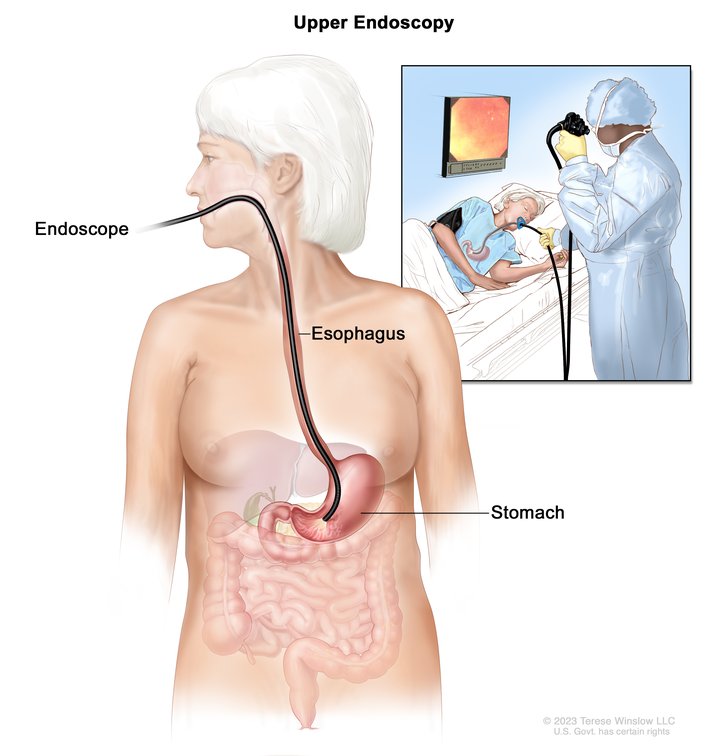Diagnosis of GI Bleeding
How do doctors diagnose GI bleeding?
Your doctor will ask about your medical and family history and perform a physical exam. Doctors may also order tests to diagnose gastrointestinal (GI) bleeding, find out how severe the bleeding is, and find its cause.
Medical and family history
Your doctor may ask about your
- symptoms
- medicines, including any over-the-counter medicines you take, such as nonsteroidal anti-inflammatory drugs (NSAIDs)—including aspirin—and blood thinners
- medical history, including any history of GI bleeding or conditions that can cause GI bleeding
- family history, including any conditions that can cause GI bleeding
Physical exam
During a physical exam, your doctor may
- check your vital signs, including blood pressure, heart rate, and temperature
- press on your abdomen to feel for tenderness or masses
- use a stethoscope to listen to your heart and sounds within your abdomen
The physical exam may also include a digital rectal exam.
What tests do doctors use to diagnose GI bleeding?
Your doctor may order tests to help diagnose GI bleeding, find the source of bleeding, or find its cause. In some cases, doctors can both diagnose and treat GI bleeding at the same time.
Lab tests
To help diagnose GI bleeding and find the cause, doctors may order
- stool tests. A health care professional will give you a container for catching and storing the stool. You will receive instructions on where to send or take the container so the stool can be studied. Stool tests can show occult bleeding.
- blood tests. A health care professional will take a blood sample from you and send the sample to a lab. Blood tests can show how severe your GI bleeding is and whether you have anemia.
Endoscopy
Endoscopy tests help diagnose and find the cause of bleeding in the GI tract.
During an endoscopy, doctors use an endoscope—a long, flexible, narrow tube with a light and tiny video camera on one end—to view inside the GI tract. Doctors may take biopsies during endoscopy tests to help diagnose the cause of GI bleeding. In some cases, doctors can treat active GI bleeding or prevent further bleeding during an endoscopy.
Doctors may order several types of endoscopy tests, which include
- upper GI endoscopy to see inside your esophagus, stomach, and duodenum
- enteroscopy to see inside your small intestine
- colonoscopy to see inside your rectum and your entire colon
 View full-sized image Doctors use endoscopy tests to help diagnose and treat bleeding in the GI tract.
View full-sized image Doctors use endoscopy tests to help diagnose and treat bleeding in the GI tract.
Capsule endoscopy
Capsule endoscopy tests check for GI bleeding in the small intestine, which is over 20 feet in length.
For a capsule endoscopy test, you swallow a capsule that contains a tiny camera, and you wear a device called a recorder. As the capsule passes through your GI tract, the camera records images and sends the images to the recorder. You will return the recorder to your doctor. Your doctor will review the images to check for active bleeding and find the cause and location of the bleeding. The capsule will leave your body during a bowel movement and can be flushed down the toilet.
Imaging tests
X-ray imaging tests can help find the source or cause of GI bleeding.
Doctors may order other imaging tests, such as
- computed tomography (CT) and CT angiography (CTA), which use a combination of x-rays and computer technology to create images
- radionuclide scanning, in which you receive an injection of a small amount of radioactive material, and a special camera takes pictures that highlight the radioactive material and show GI bleeding
Other imaging tests
Angiography
Angiography uses special dye and x-rays to see how your blood flows through your blood vessels. Doctors usually order this test for a person with GI bleeding if other tests haven’t been able to treat the bleeding.
A doctor inserts a catheter into your blood vessel, adds the dye, and then takes x-ray images. Doctors will analyze the images for signs of active GI bleeding. Doctors may be able to treat GI bleeding during an angiography.
Surgery
Doctors may recommend surgery to find the source and cause of GI bleeding if
- you have severe bleeding that doesn’t stop
- doctors can’t find the exact source or cause of GI bleeding with endoscopy or imaging tests
The surgery may be laparoscopic or open. During laparoscopic surgery, surgeons make small cuts in your abdomen and insert a laparoscope—a thin tube that has a tiny video camera and light attached—and other tools. In open surgery, surgeons make a larger cut to open your abdomen.
In some cases, doctors can diagnose and treat GI bleeding at the same time.
This content is provided as a service of the National Institute of Diabetes and Digestive and Kidney Diseases
(NIDDK), part of the National Institutes of Health. NIDDK translates and disseminates research findings to increase knowledge and understanding about health and disease among patients, health professionals, and the public. Content produced by NIDDK is carefully reviewed by NIDDK scientists and other experts.

